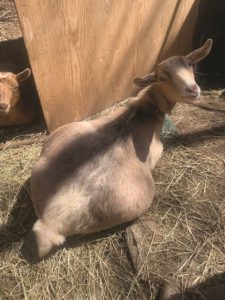At first, it can be hard to tell whether your doe — your female goat, that is — has gotten pregnant.
For those new to animal husbandry: don’t expect a missed period to alert you to anything. Female goats do not have periods in the same way humans do. In fact, it turns out that only a relatively few animals — some primates and bats, the elephant shrew, and the spiny mouse — share this trait with us.
But female goats do have estrous cycles, or “go into heat,” about every 21 days, when various reproductive hormones kick into gear, making them receptive to breeding. This lasts only two or three days, and while you might hear her bleating a little more than usual or see her wagging her tail and pacing when it’s happening, goat heat is not an especially obvious thing.

When we brought home our new buck, Lance Romance, at the end of November, we didn’t think Princess Buttercup was in heat. And besides, we didn’t keep him around for long. We sent him off to charm the does on another homestead. Since goat pregnancies last about five months, we figured that with his return in January we would be comfortably on schedule for June kidding.
We were wrong. In early April, I realized that our “Butters” was already about to pop. How could we have missed this? Well, most domesticated does have beach-ball bellies, and our doe is no exception. That’s why the fact that she was carrying kids became obvious so late and so suddenly. It’s a good thing that, for most of the pregnancy, goats don’t need a lot of special care beyond good nutrition and plenty of water.
At this late stage, though, we’re making high-speed birth preparations. About two to six weeks prior to kidding, a doe should be vaccinated for clostridial enterotoxemia, a rare but serious bacterial infection found in goats and sheep, and for tetanus. That way some immune protection will be passed on to the kids through the colostrum, or extra-thick, vitamin A-, mineral-, and antibody-rich milk she produces in the first days after birth. Farm vets are few and far between on Cape Cod, but you can safely vaccinate your own does.
A few weeks before labor, you should see your doe’s udder begin to fill out with milk. Now’s the time to section off a birthing stall in your pen. Other goats in your herd can be curious and get in the way of the birth or even show aggression toward newborn kids.
Most domestic does seem to appreciate human presence during labor and sometimes they need assistance during the pushing stage of the birthing process, though, thankfully, a vet is rarely needed. Read up, you’ll need the confidence — and readiness to face some blood and goo — to catch a baby goat or two yourself. (Two kids per pregnancy is the average.)
We have now set up a baby monitor in the pen and we’re checking for signs of imminent labor — she will act restless, look back at her sides, paw at the bedding, and get vocal. Expect to spend days trying to figure out if it’s time, but when it is, the actual delivery will take only about an hour, especially with a doe like Butters, who has given birth before.
Here’s hoping for a birth in the sunshine, not the middle of the night or in the last nor’easter of the spring.



